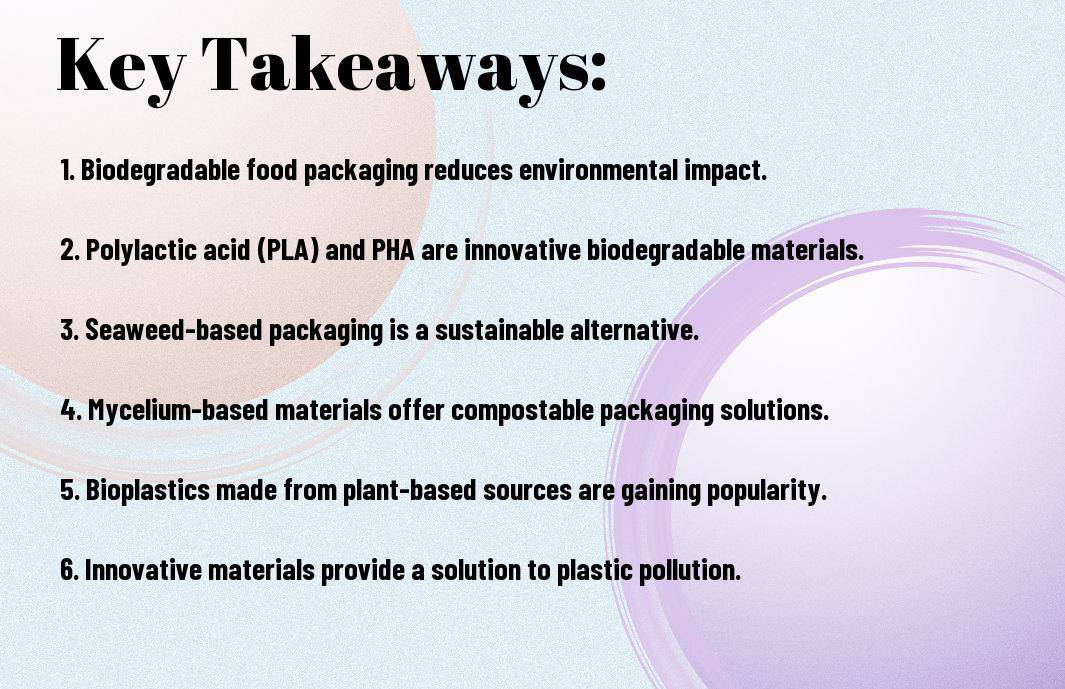Do you ever wonder if biodegradable packaging materials are a viable option for storing and preserving your food? In today’s world, it’s crucial to be aware of the impact of non-biodegradable packaging on the environment and our health. In this article, you will discover the latest breakthroughs in biodegradable materials for food packaging, and how they can benefit you and the planet. You can find more information on this topic in this Biodegradable Packaging Materials for Foods Preservation study.
Key Takeaways:
- Biodegradable materials: There are innovative biodegradable materials such as PLA, PHA, and PBAT that are being used for food packaging, offering a sustainable alternative to traditional plastic packaging.
- Properties: These biodegradable materials have properties such as being compostable, renewable, and non-toxic, making them a viable option for eco-friendly food packaging solutions.
- Regulations and adoption: Despite the potential of biodegradable materials, there are still challenges in terms of regulations, cost, and consumer adoption, but ongoing research and development are continuously improving these innovative options.

The Science of Biodegradable Materials
When it comes to finding innovative biodegradable materials for food packaging, it’s important to understand the science behind biodegradation and the latest developments in this field.
Understanding Biodegradation Process
Biodegradation is the process by which organic substances are broken down by the enzymes produced by living organisms. When it comes to biodegradable materials for food packaging, it’s crucial to know that they are designed to break down into natural components when exposed to specific environmental conditions, such as heat, light, and moisture. This process helps to reduce the environmental impact of packaging waste, as it allows these materials to decompose naturally, rather than persisting in the environment for hundreds of years.
Innovations in Biodegradable Materials
Recent innovations in biodegradable materials have seen the development of advanced polymers, such as PLA (polylactic acid) and PHA (polyhydroxyalkanoates), which are derived from renewable resources such as corn starch or sugarcane. These materials offer an eco-friendly alternative to traditional plastics, as they are capable of breaking down naturally without releasing harmful toxins into the environment. Additionally, researchers are exploring the use of agricultural waste and by-products, such as cellulose and chitosan, to create biodegradable packaging materials, further reducing the reliance on fossil fuels and minimising waste.
Current Innovations in Biodegradable Food Packaging
In the ever-evolving landscape of food packaging, there are ongoing efforts to develop innovative biodegradable materials that can effectively replace traditional plastic packaging. These materials aim to reduce the environmental impact while preserving the quality and safety of the packaged food. If you are interested in learning about the latest developments in biodegradable food packaging, you can check out the blog post on 15 Innovations in Packaging Materials We’re Excited About.
Plant-based Biodegradable Packaging
Plant-based biodegradable packaging is gaining attention as a viable alternative to plastic packaging. These materials are derived from renewable resources such as cornstarch, sugarcane, and cellulose. They are designed to decompose naturally, reducing the environmental impact of packaging waste. Many companies are investing in the development of plant-based biodegradable packaging to offer sustainable solutions for food packaging needs.
Edible Biodegradable Packaging
Edible biodegradable packaging takes a unique approach by providing packaging materials that are not only biodegradable but also safe for consumption. These innovative materials are designed to be eaten along with the packaged food, eliminating the need for disposal. They offer a novel way to reduce packaging waste and provide additional benefits such as enhanced food preservation and extended shelf life.
Bioengineered Materials for Packaging
Bioengineered materials for packaging involve the use of advanced technologies to create biodegradable polymers with specific properties suitable for food packaging. These materials can be tailored to offer the desired strength, barrier properties, and biodegradability, making them suitable for a wide range of food packaging applications. Bioengineered materials represent a significant advancement in sustainable packaging solutions, offering a promising alternative to conventional plastic packaging.
Innovation in biodegradable food packaging is crucial for addressing the environmental challenges associated with conventional plastic packaging. Plant-based, edible, and bioengineered materials are just a few examples of the exciting developments in this field, offering sustainable alternatives with the potential to revolutionise the way we package and consume food. As you stay informed about these advancements, you play a part in promoting a more sustainable future for food packaging.
Case Studies of Biodegradable Packaging Innovation
When it comes to biodegradable food packaging, there have been significant developments in recent years. Innovative companies have been making strides in developing sustainable and eco-friendly alternatives to traditional plastic packaging. Here are some case studies of biodegradable packaging innovation that have made a substantial impact:
- 1. Avani Eco – Avani Eco, a company based in Bali, has developed a biodegradable and compostable plastic alternative made from cassava root starch. Their innovative packaging solutions have been widely adopted by businesses in the food and beverage industry.
- 2. Tipa Corp – Tipa Corp has designed fully compostable and flexible packaging solutions that mimic the properties of plastic but biodegrade in compost environments. Their products have gained popularity among food manufacturers looking for sustainable packaging options.
- 3. Vegware – Vegware offers a range of compostable food packaging made from renewable, plant-based materials. Their items, such as cutlery, takeaway containers, and cups, have gained traction in the food service industry for their eco-friendly attributes.
Success Stories of Biodegradable Packaging in Food Industry
Several success stories demonstrate the successful integration of biodegradable packaging in the food industry. Businesses across the globe have embraced biodegradable packaging to show their commitment to sustainability. By adopting these eco-friendly solutions, companies have not only reduced their environmental impact but have also gained positive recognition from environmentally conscious consumers.
Challenges in Implementing Biodegradable Food Packaging
While the shift towards biodegradable food packaging is commendable, it also comes with its own set of challenges. One of the main hurdles is the cost implications associated with biodegradable packaging materials. Additionally, ensuring that biodegradable packaging meets the required standards for food safety and preservation poses a challenge for manufacturers. It is essential to address these obstacles to facilitate a smoother transition towards sustainable packaging alternatives.
The Future of Biodegradable Food Packaging
As consumer demand for sustainable packaging solutions increases, the future of biodegradable food packaging looks promising. Innovations in biodegradable materials and packaging designs are continually being developed to meet the growing need for environmentally friendly alternatives to traditional plastic packaging.
Predicted Innovations in Biodegradable Packaging
In the coming years, you can expect to see a surge in innovative biodegradable packaging materials and technologies. Manufacturers are exploring the use of advanced materials such as plant-based bioplastics, compostable films, and edible packaging. These materials not only offer biodegradability, but also provide functional and aesthetic benefits without compromising on food safety and shelf life. Additionally, advancements in biodegradable coatings and barrier solutions are likely to improve the performance and versatility of biodegradable packaging.
The Impact of Biodegradable Packaging on Our Environment
The shift towards biodegradable food packaging has the potential to significantly reduce environmental pollution and the strain on natural resources. By opting for biodegradable packaging, you can help minimise the accumulation of plastic waste in landfills and marine ecosystems. Moreover, the use of renewable resources in biodegradable packaging can contribute to lowering greenhouse gas emissions and overall environmental impact. Choosing biodegradable packaging empowers you to make a conscious effort towards preserving our planet for future generations.
Conclusion
Hence, it is clear that there are indeed innovative biodegradable materials available for food packaging. As awareness of environmental issues continues to grow, more and more companies are investing in the development of sustainable packaging solutions. From seaweed-based films to bioplastic options, there are several alternatives to traditional plastic packaging that are not only biodegradable, but also cost-effective. By making the switch to biodegradable food packaging, you can contribute to reducing the environmental impact of waste while also meeting consumer demands for eco-friendly options.
FAQ
Q: What are biodegradable materials for food packaging?
A: Biodegradable materials for food packaging are types of packaging that can break down naturally in the environment, reducing the amount of waste in landfills and oceans. These materials are typically made from plant-based sources such as cornstarch, sugarcane, and cellulose.
Q: Are there any innovative biodegradable materials for food packaging?
A: Yes, there are several innovative biodegradable materials for food packaging, including bioplastics made from algae, mycelium-based packaging grown from mushrooms, and edible packaging made from seaweed. These materials offer sustainable alternatives to traditional plastic packaging.
Q: How do biodegradable materials benefit the environment?
A: Biodegradable materials for food packaging help reduce the amount of plastic waste that ends up in landfills and oceans. They also require fewer natural resources to produce and often have a lower carbon footprint compared to conventional plastic packaging.
Q: Are biodegradable materials as durable as traditional plastic packaging?
A: While some biodegradable materials may not be as durable as traditional plastic packaging, advances in technology have led to the development of biodegradable materials that offer comparable durability. It’s important to consider the specific requirements of the food product and packaging needs when choosing biodegradable materials.
Q: How can businesses switch to biodegradable food packaging?
A: Businesses can switch to biodegradable food packaging by sourcing packaging materials from suppliers that offer biodegradable options. It’s important to ensure that the chosen materials meet regulatory standards and comply with food safety requirements. Businesses should also educate consumers about the benefits of biodegradable packaging to encourage adoption and support for sustainable practices.



